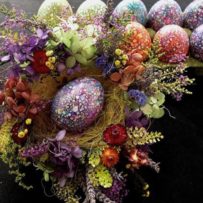The Colorful History of the Decorated Egg

To adorn an egg shell, is to participate in one of the oldest forms of arts and crafts. From ancient to modern times, eggs have been an important symbol in many cultures. They are part of the creation myths of many peoples as they symbolize life, renewal, and rebirth. In folklore, they were often used for healing and protection.
In pagan traditions, Ostara heralds the beginning of spring and honors the goddess Eostre. Eostre is said to have revived a bird whom she found dying with frozen wings. She transformed the bird into the iconic egg-laying hare that became an important part of spring festivities. The transformed rabbit was said to have gifted Eostre with colorful eggs for her celebrations each season.
Decorated ostrich shell pieces and empty eggs in Africa have been found in tombs or archaeological digs dating back to ancient times. Sculptures of ostrich eggs in gold and silver were often placed in graves of the Sumerians and Egyptians. Shells were decorated with distinct carved scratch marks, and later with red ocher coloring to accentuate those carved embellishments. Hen’s eggs, or stones carved into the shape of an egg, have also been found in ancient Roman tombs.
Colored eggs appear on altars for the vernal equinox, widely practiced across Europe and Asia. Eastern Europe has a tradition of elaborately adorning eggs with wax and dyes to create some of the most beautiful varieties. Eggs from the Ukraine and surrounding regions are among the most vibrant, with many layers of colors. In Jewish traditions, it is the pure white roasted egg that appears during Passover. Early Christians also adopted the tradition and dyed their eggs red to represent the blood of Christ.
In ancient Greece, there is a custom of baking whole red eggs into braided sweet bread loaves. Lichens, vegetables such as beets and spinach, and flower petals have been used to dye eggs. In northern Britain and in Scandinavia, a leaf or flower is placed on an egg, wrapped in onion skins and then boiled. The result is an egg with the impression of a leaf or flower design on it. In Britain these are called “pace eggs” and are given as gifts, and used as a kind of payment to performers of springtime folk plays.
Decorated eggs have customarily been given as gifts, to preserve the health of the recipient. A bowl of decorated eggs were often kept in the home year-round, to protect the inhabitants. Eggs were buried near doorways of homes, to protect the health of the family there. Buried eggs were also placed near barns to protect the families’ animals. In China, red eggs are given as gifts to a bride and groom in hopes of bearing a child. The egg is purported to bring fertility to newlyweds, and then to bless their newborn with good fortune.
When dying eggs naturally try red beets, red cabbage, spinach, yellow onion skins, cumin, turmeric and coffee.
The particularities of egg decor have specific meaning as to what type of protections they may offer. This spring, you may want to decorate boiled eggs in a manner that resonates with you. With so many new techniques with which to decorate, you can let your creativity unbound. Sigils, patterns, colors, and even words of significant personal meaning are a great way to start. Place your finished eggs anywhere you want to draw in good health and blessings. Give some away to loved ones not in your household to enhance their blessings. May the eggs you create this spring bring you all that you seek!
Until next time, witches… blessed be!




Recent Comments